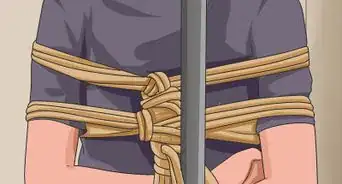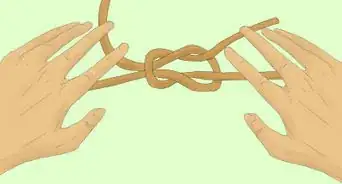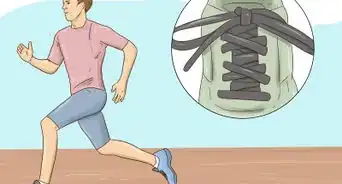This article was co-authored by Britt Edelen. Britt Edelen comes to wikiHow after graduating in 2019 from Brown University, where he studied English and German literature and philosophy. While at Brown he contributed frequently to campus publications and worked in the university’s Writing Center. More recently, he has had several articles published in various journals devoted to literary criticism. During his time at wikiHow, Britt supervised and collaborated with writers and editors to continue producing high-quality content and promote wikiHow’s mission of enabling everyone to learn anything.
There are 7 references cited in this article, which can be found at the bottom of the page.
This article has been viewed 702,731 times.
Whether you're a rock climbing fiend, a boating fanatic, or just someone who would like to know how to attach a rope to something, you're going to need to know how to tie knots. Read on to learn the simple steps used to tie general knots, knots used for rock climbing, nautical knots, and knots used for very specific purposes.
Steps
Tying General Knots
-
1Tie an overhand knot. Overhand knots are probably the easiest, and first, knot that people learn to tie. [1]
- Make a loop that looks like the loop of a roller coaster. Insert one end of the string into the loop. Pull both ends in opposite directions so that the knot becomes tight.
-
2Tie a bowline knot. This knot, also called a bowline hitch, makes a fixed loop at the end of a rope or string. The loop can be secured over an object like a post or passed through a ring or hole before the knot is tied.[2]
- Hold one end of the string in each hand. Make a loop with the end of the string in your left hand. The end should be under the main portion of the string.
- Put the end of the string that is in your right hand through the loop that you have made with your left. The right hand end should come towards you as it goes through the loop.
- Bring the right end up and around the left end (that should be pointing up since you created the loop with it.)
- Pull the right end back through the loop. This time the end should go away from you. Pull the two ends away from each other so that the knot is tight.
Advertisement -
3Tie a square knot. Square knots are also called reef knots. The square knot is a simple, handy knot for temporary ties that helps hold 2 pieces of rope together.
- Hold an end of the rope in each hand. Cross the end in your right hand (end A) over the end in your left hand (end B) so that the rope forms an X.
- Wrap end A so that it goes under end B and comes up again. Bring end A back over end B to form a half-knot.
- Place the top of end A over the top of end B. Bring end A back over end B to form an overhand knot. Pull tightly on all four ‘ends’ coming out of the knot. The result should be a knot that looks like a loop stuck in another loop.
-
4Tie sheet bend knots. Sheet bend knots are used to tie two ropes together.
- Form a loop (also called a bight) out of one rope (rope A) and hold the loop together with your hand. Take the other rope (rope B) and run one of its ends through the loop.
- Pull the end of rope B so that it goes up through the loop and wraps under both parts of the loop.
- Take the end of rope B and pull it up and under itself where it comes up out of the loop. Pull both ropes away from each other to secure the knot.
Tying Climbing Knots
-
1Double Bowline knot is used in climbing.
- Make two loops of equal size stacked on top of each other. Take the end of the rope farthest from the two loops (end A) and wrap it over your tie-in point (wrap it from the back over to the front.)
- Thread end A through the hole created by the two loops. Wrap end A around the other end (end B) that is shorter and near the two loops.
- Thread end A back through the two loops, making sure that it is wrapped around end B.
-
2Tie a re-threaded figure-of-eight knot. The re-threaded figure-eight knot, also called a figure-of-eight follow-through, is used by climbers to tie into a harness.
- Make a loop in the rope so that there is about five feet (1.5 meters) of loose rope at one end (end A). Make the loop so that end A wraps around the bottom of the loop and over the rest of the rope (end B.)
- Thread end a through the loop and pull tight. This should form a figure-eight in the rope where the loop was. Loop end A through your harness.
- Thread end A through the top loop of the figure-eight. Wrap end A around end B and pull end a up through the bottom of the figure-eight, loop it over the top of end B and back through the top of the figure-eight so that it comes out the bottom of the figure-eight.
-
3Tie a prusik knot. Prusik knots are used to tie a loop around a rope so that a rope can be climbed. It is a classic ascending knot that is often used for self-rescue.
- Take a small rope or chord (rope A) and pull it under the rope you want to climb (rope B.) Form a loop with rope A and pull the loop over rope B. The two ends of rope A should hang down under rope B.
- Pull the loop over rope B and around again so that it is back up on the other side. Repeat this step three to five times, depending on the thickness of your rope.
- Bring the ends of rope A through the loop. Doing this will secure rope A to rope B. When you pull on the ends of rope A, the knot will stay in place. When you loosen the knot, the knot will be able to slide up and down rope B.
Tying Boating Knots
-
1Tie clove hitch knots. Clove hitch knots are fairly simple knots that can be useful for securing ropes to trees, posts, or other things that stand upright or horizontal.[3]
- Wrap the running end of the rope (end A) halfway around the pole or object that you are tying the rope to. The running end of the rope is the end that will be loose after you tie the knot.
- Wrap end A over the part of the rope resting against the pole. This should form an X. Wrap end A back over the pole.
- Lift the X that has been formed up off of the pole. Slide end A under the X and pull on end A firmly to secure the knot.
-
2Tie a trucker’s hitch. Trucker’s hitches are used for lifting heavy loads and tensioning lines. On a boat, it can be used to lash things to the deck or secure them down below. Use it in combination with a bowline and half hitch for a very secure knot.
- Wrap the end of a rope (end A) around the object you want lifted. If you want to place a tensioned line between two objects, wrap the end around one of them (object A).
- Create a bowline knot (or some other fixed knot) high up against object A with end A. Take the other end (end B) and wrap it around an anchor, such as a heavy rock, tree or pole, and then loop it up through the bowline (or other fixed knot.) If you are working with two objects, loop it around the other object (object B.)
- Pull on end B to lift the object or add tension. You should be able to lift with two times the power you would normally have.
-
3Tie an anchor bend knot. Anchor bends are used to tie rope to a ring or other similar object. It is used particularly when securing a boat to a ring or other form of anchor.[4]
- Loop the end of the rope through the ring twice. This will give you an end rope and the standing line (the part of the rope that is fastened to your boat.
- Wrap the end around the standing line and pull it under the first loop around the ring. Pull it so that there is no sagging part of the rope.
- Wrap the end around the standing line again and then tuck the end under itself (this is called a half hitch.)
Tying Knots for Specific Uses
-
1Palomar knot is used to secure a fishing line to the hook.[5]
- Put one end of the fishing line (end A) through the round hole at the top of the hook. Pull the same end back through the hole but be sure to not pull it all the way. You should have a loop on one side of the hole and the two ends of the line on the other.
- Create circle by bringing the loop over and forming a loop on top of the two ends. Wrap the end of the loop through the hole created but do not pull it tight yet.
- Pull the hook through the end of the loop (which should be rather small now.) Pull the hook and ends of the line in opposite directions so that the knot is tightened. Cut off the end of the line that is not connected to the fishing pole.
-
2Chinese Sliding knots are useful when making adjustable necklaces.[6]
- Lay the ends of the string so that the ends lie parallel to each other. They should run parallel for about four inches (10 cm).
- Pull the end of the right chord (end A) so that it doubles back four inches (10 cm). It should make a long C shape. Hold the chord down and loop the same end back four inches (10 cm) leaving some chord at the end of end A (you will need it to finish the knot.)
- Wrap end A around all of the stacked up lengths of switch-backing chord. Wrap the end from front to back several times. Feed end A through the loop.
- Slide the wrapped loops down so that the knot is tightened. End B (the left end) should be able to move freely when pulled. Make another of these knots if you wish.
-
3Quick release knots are used to tie a horse up so that when required the rope can be released by pulling the loose end.[7]
- Take a rope and fold it in half. Take the loop made in the middle and wrap it around a pole from the back of the pole to the front. The left side of the rope will be the quick-release end (end A) and the right side of the rope with be the standing end (end B).
- Make a loop (loop 1) using end B. Pull that loop through the original loop that is wrapped over the pole.
- Make a loop (loop 2) using end A. Pull loop 2 through loop 1. Pull down on end B to tighten the hitch. Pull end A for the quick-release.
Community Q&A
-
QuestionHow do I tie a hard knot?
 Community AnswerYou can use a double knot, which means to follow the steps of tying a knot twice. Or you can look up more difficult, but sturdier, knots.
Community AnswerYou can use a double knot, which means to follow the steps of tying a knot twice. Or you can look up more difficult, but sturdier, knots. -
QuestionWhat knot is good to use when I play an escape challenge game?
 Community AnswerGenerally, I use a double knot, as it holds everything and is really quick and easy.
Community AnswerGenerally, I use a double knot, as it holds everything and is really quick and easy. -
QuestionHow do I tie a holding knot to use with salami?
 Community AnswerFollow the directions listed in the article above.
Community AnswerFollow the directions listed in the article above.
References
- ↑ http://www.iwillknot.com/overhand_knot/
- ↑ http://www.animatedknots.com/bowline/
- ↑ http://www.netknots.com/rope_knots/clove-hitch
- ↑ http://www.netknots.com/rope_knots/anchor-bend
- ↑ http://www.leadertec.com/tipsandtechniques/fishing_knots/knots_palomar.html
- ↑ https://www.youtube.com/watch?v=pUqhGULW4vY
- ↑ http://askmax.countrymax.com/equineDetail.php?Quick-Release-Knot-22
About This Article
Whether you’re going boating, doing arts and crafts, or just trying to fasten something down securely, being able to tie knots is an important skill. One of the easiest kinds of knots is the overhand knot. To make one, create a loop in the middle of a line, such as a length of rope or string. Then, pull one of the ends of the line through the loop to make a pretzel shape. Pull on both ends of the line to tighten the knot. To make a knot at the end of a line—for example, if you want to attach something to a hitch or tow-rope—a bowline knot is a good option. To start, make a loop close to the end of the line. Then, pull the free end of the line through the loop from behind to create a second, larger loop. Next, pass the end of the line under the main length of the line and bring it back around again so that it passes down through the original loop a second time. Pull both ends of the line to tighten the knot. For a quick and simple knot that’s easy to untie, try a square knot. Grab an end of your line in each hand, then pass the right end over the left to create an X. Take the end that is now in your left hand and wrap it under and around the end in your right hand to make a half-knot, just like when you’re tying your shoe. Next, cross the ends of the rope over each other again to make another X above the first one, and then wrap one end around the other to make a second half-knot. Pull on all 4 lines coming out of the knot to tighten it. If you need to tie 2 lines together, opt for a sheet bend knot. To do this, fold over the end of one line to create a loop, and hold the loop in place with your hand. Pull the end of a second line through the loop you just made, then wrap the end of the line around behind the bottom of the loop. Pass the end of the second line back through the loop in the first rope, then pull the end under the part of the second rope where it originally entered the loop. Pull both ropes in opposite directions to tighten the knot. Keep reading the article if you want to learn how to tie special knots for climbing or boating!

























































